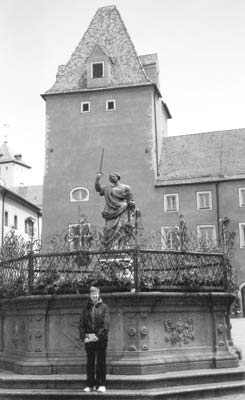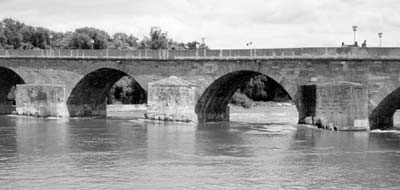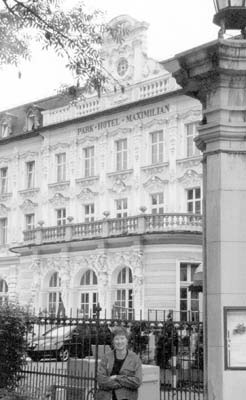Where do Germans go on vacation in Germany? Regensburg!
by Carol H. Probst, Bethel Park, PA
“Und ver did you hear about Regensburg? Ve vish to keep that city to ourselves!” This comment, from a German woman in Heidelberg after she learned we had visited Regensburg, was cause for reflection. In June ’06 my husband and I, as part of our 3-country European trip, spent an entire weekend in Regensburg. Suddenly, we understood why the only other language we had heard there was German.
The city seems to be a popular destination for Germans but appears far less renowned among foreign visitors. What a shame, for it boasts numerous attractions and has been called the best-preserved medieval city in Germany.
An introduction
Situated on the Danube, 76 miles northeast of Munich, Regensburg is a convenient stopover when driving or taking the train to Prague from Munich.
After a 2-hour leisurely train ride, my husband and I arrived at the Regensburg station around noon. I had chosen to visit Regensburg for its rich history. It boasts a Roman tower and gate, Porta Praetoria, which is the second-oldest building north of the Alps. Additionally, a stone bridge built over the Danube in the 12th century was considered the Eighth Wonder of the World during the Middle Ages.
A short 2-block walk brought us to our hotel, the attractive 4-star Park Hotel Maximilian, which I had chosen for its proximity to the train station. It was situated within a beautiful courtyard and terrace complex, complete with fountain and located across from a lovely municipal park. The hotel was built in 1891 and has been lavishly renovated.
Too early to check in, the receptionist graciously stored our bags and provided a map to the Old City’s visitor center, from where the only English walking tour of the week was scheduled to depart at 1:30 p.m. A 15-minute stroll along a pleasant pedestrian-zone street brought us to the heart of the medieval city. As it was a beautiful Saturday, there were plenty of tourists about, but they all seemed to be German. Only seven people were present for our English-language tour (less than €15 for the two of us), but our guide seemed pleased by the “nice turnout.” The jaunt lasted over an hour and was fascinating.
Centuries-old structures
The confluence of the Regen and Danube rivers provided an ideal site for the original Roman fortress which was laid out here in A.D. 179. (The Roman inscription on a former gate can be viewed in the Town Museum.) When the forefathers of the Bavarians overtook the town, they incorporated the Roman structures, some of which can still be spotted in buildings and walls throughout the city.
The strategic location on medieval trade routes made Regensburg wealthy, and this is reflected in its great residences with their high towers plus, reportedly, the country’s best-preserved Gothic town hall. Even today, the Stone Bridge inspires awe and remains heavily utilized.
Our tour ended outside Dampfnudel-Uli (Watmarkt 4) for what our guidebook described as the best Dampfnudel (sweet dumpling) in Bavaria. How could we resist? For five euros, we split a huge Dampfnudel and agreed: the accolades were justified!
Stuffed, we decided to revisit the most imposing site in the city, St. Peter’s Cathedral. Established in 778, the present Gothic structure was begun in 1254; over time, lavish Baroque elements were added.
The cathedral and its windows are magnificent, but so are many others in Europe. What sets this one apart is its famous boys’ choir. Upon entering St. Peter’s, we discovered a Mass was in progress and, to our delight, there was the boys’ choir! We quietly slipped into a vacant pew and found the choral performance to be a most moving experience.
Leaving the cathedral, it was time to check into our hotel. We were given a lovely room and decided to have supper in the on-site Italian restaurant. The shady outdoor table provided the perfect atmosphere; unfortunately, the quality of our meal did not warrant its expense. Apparently, our early dinner hour was not solely responsible for the dearth of other patrons.
Dining options
Sunday morning was cool, with spotty sunshine. The price of our hotel included a sumptuous breakfast buffet — by far the most lavish (and tasty) we’d had in two weeks.
Our original plan for the day was to attend the 10:00 morning Mass at St. Peter’s to hear the choir again. However, the church was packed and after a half hour of standing at the back trying to peek over throngs of visitors, we quietly left.
Time for Plan B: a boat ride on the Danube. Many options were available, including full-day excursions. We chose the GTK line, located near the Stone Bridge. For €14 apiece, we took a 50-minute cruise down the Danube and up the canal to the locks of the Regen River. During the cruise, information was conveyed in English as well as German.
We finished in time for lunch — and at what better place than the Wurstkuchl, a tiny establishment next to the Stone Bridge which has been serving sausages since its inception around the 15th century? The place was bustling.
Patrons can stand in line and order or sit at one of the communal tables and try to catch the eye of a waitress. We chose the latter and eventually placed an order for the locally famous white sausages and sauerkraut (€7 each; bread is extra).
Nobody at our table spoke English, but it was a pleasant and shady spot with lots of people-watching opportunities. After a long wait, four plates of the sausages appeared, borne by a young man. He had just placed one in front of my husband when our waitress appeared and snapped, “Not your turn!” before snatching the plate away. (Eventually, our food arrived and it was delicious, but my husband’s displeasure with the waitress’ behavior was reflected in her tip.)
Determined to avoid the previous night’s dinner mistake, we detoured to the well-recommended restaurant at Hotel Bischofshof am Dom, located near the cathedral. Originally a Bishop’s residence, it contained a charming courtyard with statuary and was filled with lunchtime patrons. We made dinner reservations for later that evening.
A living castle
The comprehensive city guidebook in English purchased at our hotel was invaluable for visiting the many other historical attractions in the city. One of our favorite sites was the Niedermünster, a convent dating back to the 10th century and retaining two earlier Roman towers.
The lavish and gilded interiors reflected the financial largess of the Duchess Judith, grandmother of Emperor Heinrich II, who entered the convent after the death of her husband. Niedermünster also contains a plethora of medieval religious artwork, relics and lavish tombs.
We still intended to visit the huge castle complex that we discovered during the previous night’s walk, so we and hurried back to catch the last tour of the day at 4:00. The tour was conducted only in German, but our guide did speak English, and headphones were available in several languages to assist in translation — a most satisfactory arrangement.
The castle, known as Schloss Thurn und Taxis or St. Emmeram Castle, was originally a monastery. It had been secularized into the Emperial Collegiate in 1748 and then given to the principality of Thurn and Taxis in 1812. The palace consists of over 500 rooms; the princess is still in residence in a section of it. However, the magnificent state rooms are available for public viewing (€11.50, or $15, per person), and since only limited numbers of tours are scheduled the crowds we had encountered in other European castles were absent. Our 1½-hour tour even included the crypts from the ancient monastery.
It was a 30-minute walk back into the medieval center for dinner at the Bischofshof, but it was well worth the effort. Our meals of Wienerschnitzel and river perch were undoubtedly the best we had in Germany. Even with a glass of wine apiece and splitting a mousse dessert, the total bill was only €43.90 ($57).
We heartily recommend a visit to Regensburg. Our hotel, the Park Hotel Maximilian, met our needs perfectly, but for anyone requiring a more centralized location the Bischofshof should do nicely.
Regensburg may not remain off the international radar for long, as Pope Benedict XVI is from the area and a papal visit to St. Peter’s Cathedral is upcoming.
Accommodations
• Park-Hotel Maximilian (Maximilianstrasse 28; phone +49 [0] 941 56850, www.maximilian-hotel.de) — our spacious double with private bath cost €109 or $142, per night, including breakfast.
For reduced noise levels, avoid the side rooms that overlook the main pedestrian street. Note: this hotel has no air-conditioning.
• Hotel Bischofshof am Dom (Krauterermarkt 3; phone +49 [0] 941 58460) — a double with private bath and breakfast included cost €179, or $233, per night. No air-conditioning.




